One of the last two games of this week’s Allsvenskan on Monday night was played by AIK and Mjallby AIF at Friends Arena. Despite winning the league title just years ago, the home side struggled in the relegation battle this season. On the other hand, Marcus Lantz’s team did quite well to secure a mid-table position after promoting from the Superttan last year.
It was a game mostly dominated by AIK, which Nabil Bahoui’s goal just before the final whistle made the memorable game. This tactical analysis dissects the tactics of both managers, including the offensive and defensive organizations of the teams.
Lineups
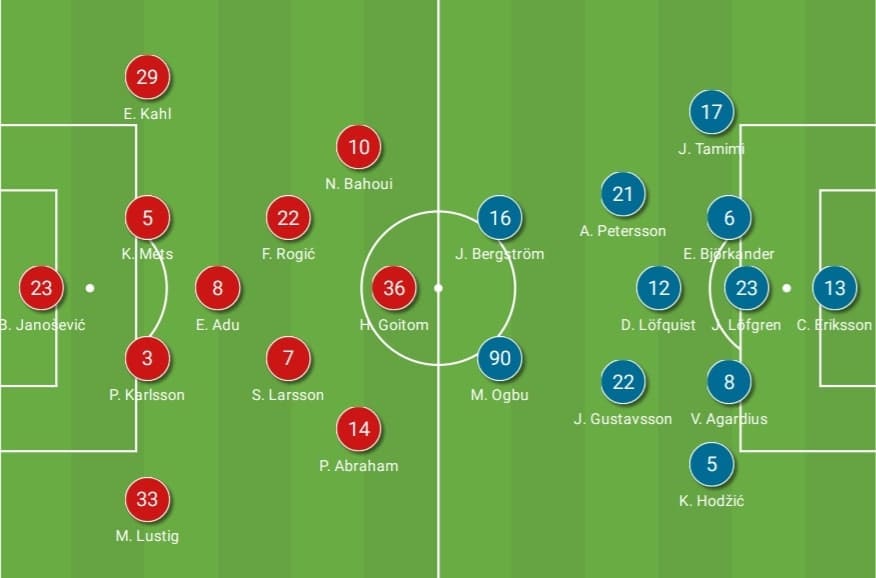
Bartosz Grzelak fielded the exact same team from the previous fixture, they played in a 4-3-3 formation, varied to other more offensive setups as the game went on.
Mjällby played with the 5-3-2 of Lantz again, keeping David Batanero and Besard Sabovic on the bench. Moses Ogbu has a decent season so far, registered eight goals in the league and his partner today was Jacob Bergström.
AIK build-up and tiki-taka
Before diving into the home side’s offensive approach, we have to understand the defensive system of Lantz’s team. In this game, the away side only have 32.45% possession, spending most of the time to defend.
The average PPDA of Mjällby was 17.89 in this game, even higher than the average of this season. The figure suggests the Mjällby were not even pressing very high to pressure the opponent.
The midblock was zone-oriented in a 5-3-2 formation, setting the first line at the halfway line. Since AIK tried to build-up through the flanks, Mjällby had to cover the wide zones with different players. The strikers – Ogbu and Bergström, were the first to cover horizontal areas respective to their heights, though it was not necessary to move into flanks to attack the ball. The wing-backs mostly spending their time to step out early on the wide players, such as the full-backs, but they were also happy to leave the duties to midfielders when the targets moved too far. Therefore, the coverage of midfield was pivotal to support the defensive system. They have to effectively cover areas between the first and last line, producing pressure on the ball if necessary.
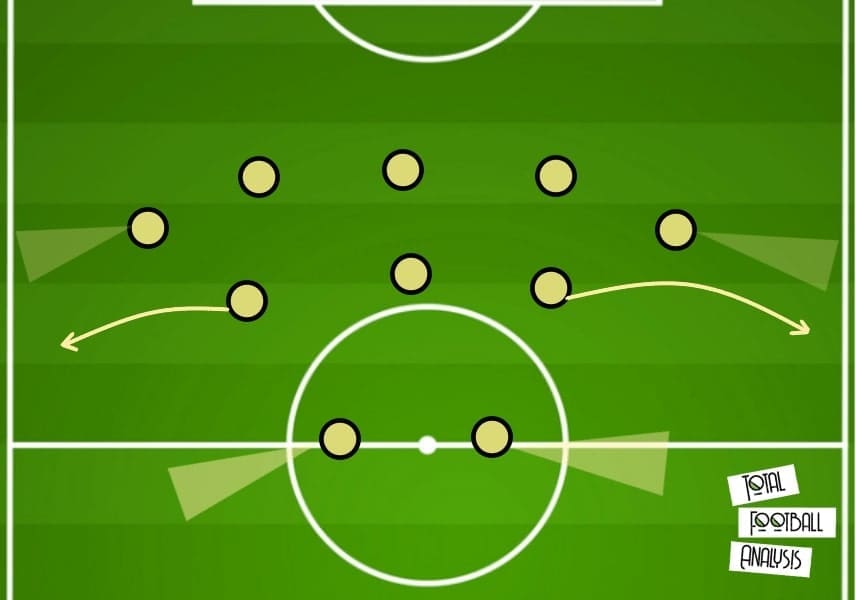
Only in the first 15 minutes of each half, Mjällby tried to press the opponent high on the pitch. The trigger was usually a backward pass, read by strikers and they will initiate the press. Under these circumstances, the defence became a man-oriented system with players pushing high to man-mark the build-up players.
Here, as a result of a return pass, Mjällby began the press which was led by Ogbu. The defending players went man-to-man, even the right wing-back, Jonathan Tamimi pushed to the second line. AIK were not at their best to play out from the back under pressure, hence, went long as a resort to eliminate press. However, the long balls were not played without clear intentions, mostly leading to possession turnover.
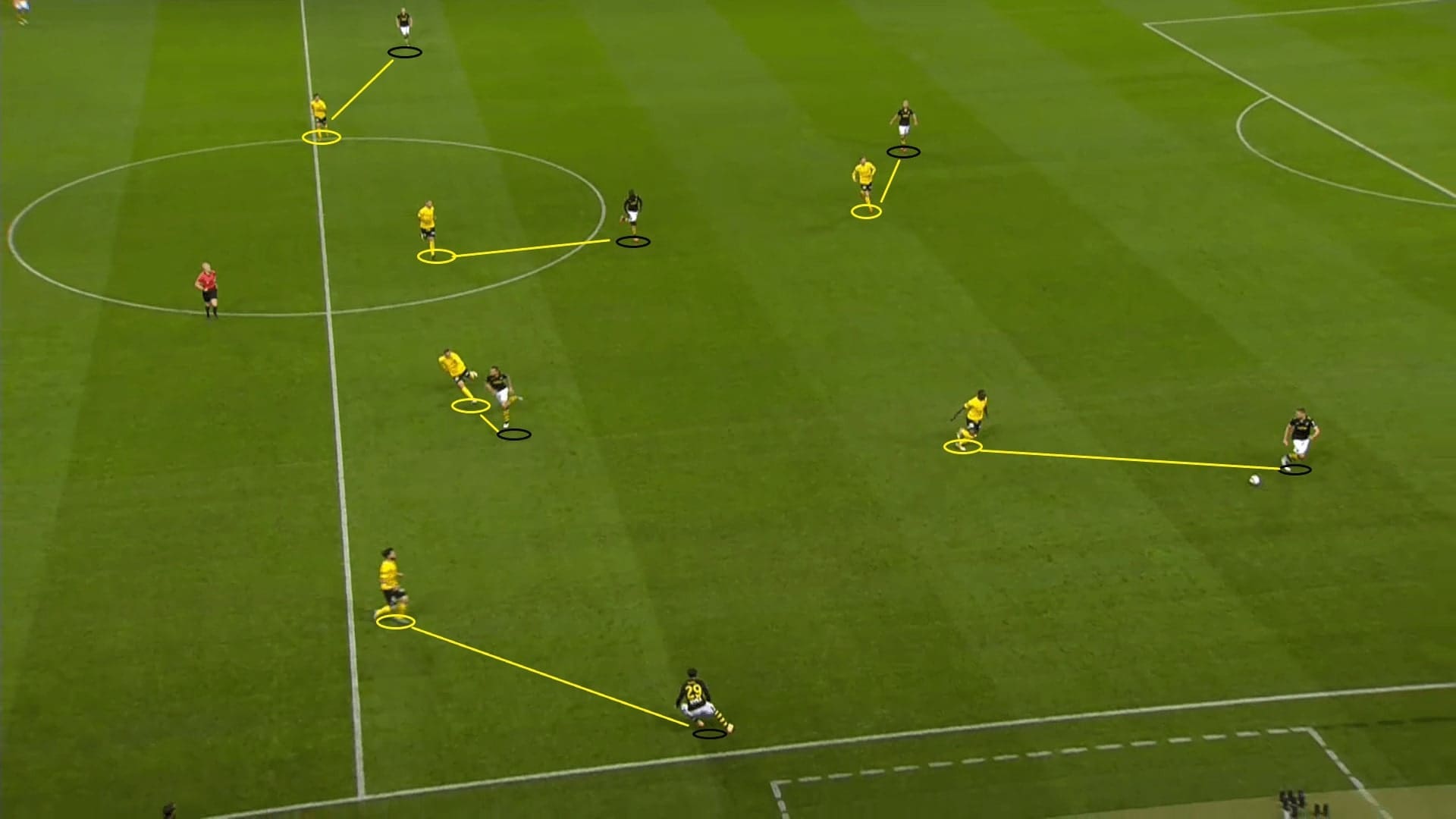
Although putting a 4-3-3 formation on paper, the shape of AIK was more like a 2-1-4-3 or a 2-3-2-3, with a pair of high full-backs to attack width. The below image is a summary of AIK’s offensive scheme. The centre-backs split wide, plus using Enoch Kofi Adu as an additional layer to overload the first line of Mjällby (3 v 2).
The full-backs were supposed to push high and occupy the wide zone in the attack, though Eric Kahl would drop to offer himself as an option sometimes. Another supportive layer was provided by the advanced midfielders, who would drop at the half-spaces to progress the ball. Also, the duo should support the full-backs at the corresponding half-spaces as the wingers inverted themselves. The front three were staying narrowly to occupy and manipulate the Mjällby centre-backs.
However, the issue of this game was facing trouble to access central zone. Despite having a strong numerical superiority in the build-up, the attack seldom reached the highlighted region, especially in the first half. The attack spent too much time to circulate the ball outside of the Mjällby block. On the contrary, what the team needed was to penetrate into those “holes”, creating a decisional crisis for the opponents.
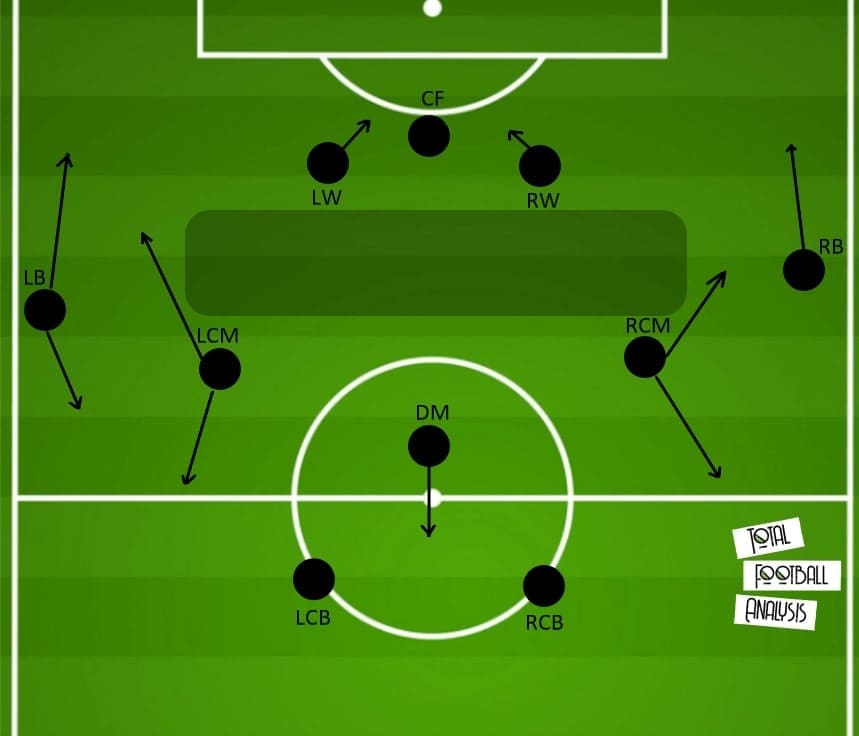
The below image demonstrates the 2-3-2-3 formation of AIK, maybe a bit similar with the one used by Pep Guardiola at Manchester City before. The control on the opposition second line was very good. The advanced midfielders stayed at the middle line to keep Mjällby midfielders narrow, while the positions of full-backs were too deep for Mjällby wing-backs to reach. Therefore, the team could progress the ball to the advanced area through Kahl in this example.
Another point was the positionings of strikers and wingers. As suggested in the above analysis, they narrowly and high to occupy the centre-backs, as well as providing the offensive heights.
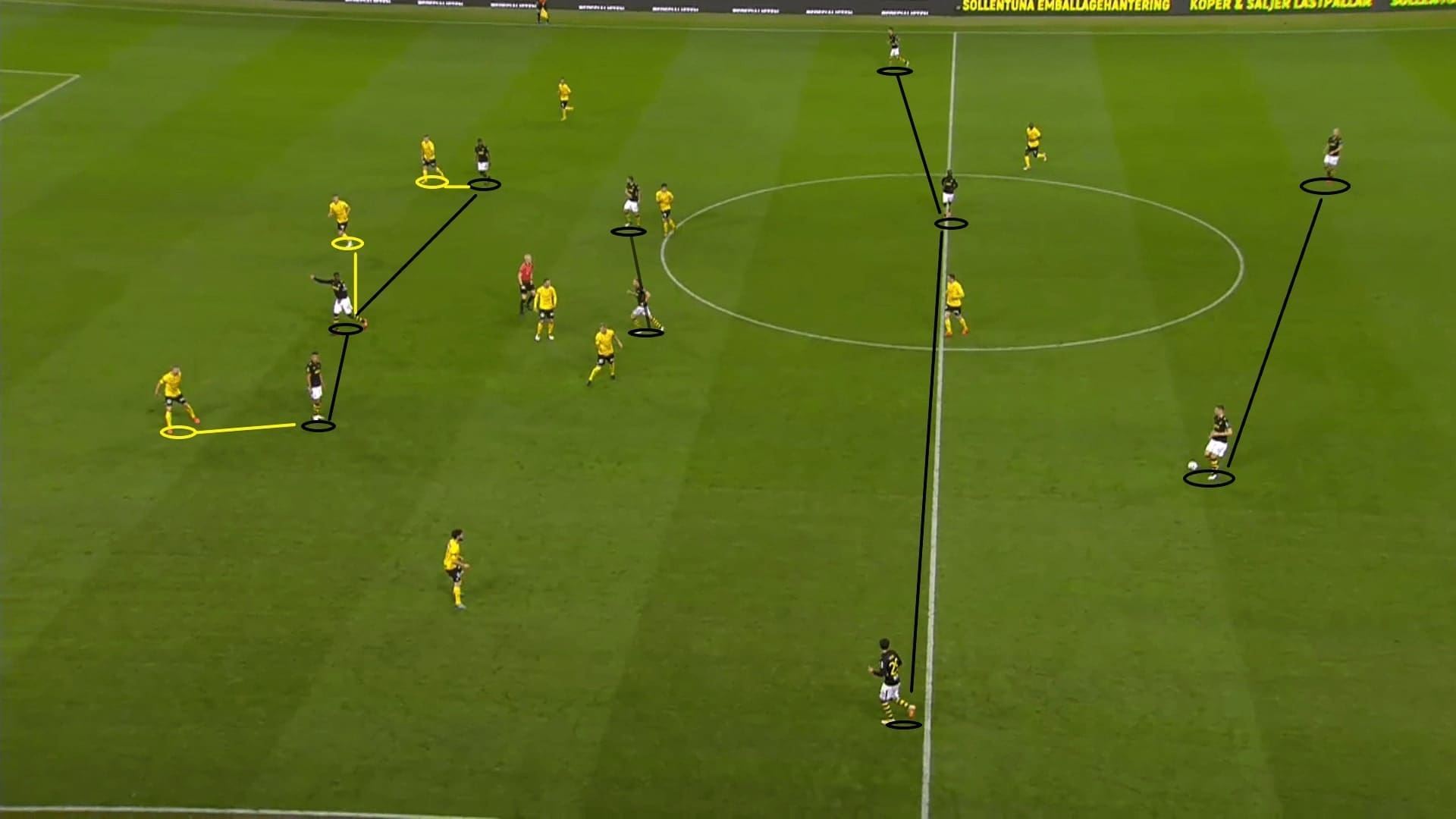
Below is a variation of AIK’s build-up, the left midfielder – Filip Rogić dropped to create a passing triangle with his teammates. This has disguised Ogbu on who to mark as now Karol Mets has two passing options, the striker could not mark both.
Also, without the dropping players, distances of AIK players were relatively large. Therefore, sometimes Rogić or former Sunderland man Sebastian Larsson moving into these positions have strengthened interconnectedness of players. This was conducive to the ball circulation flow of the attack, allowing AIK switching from flank to flank.
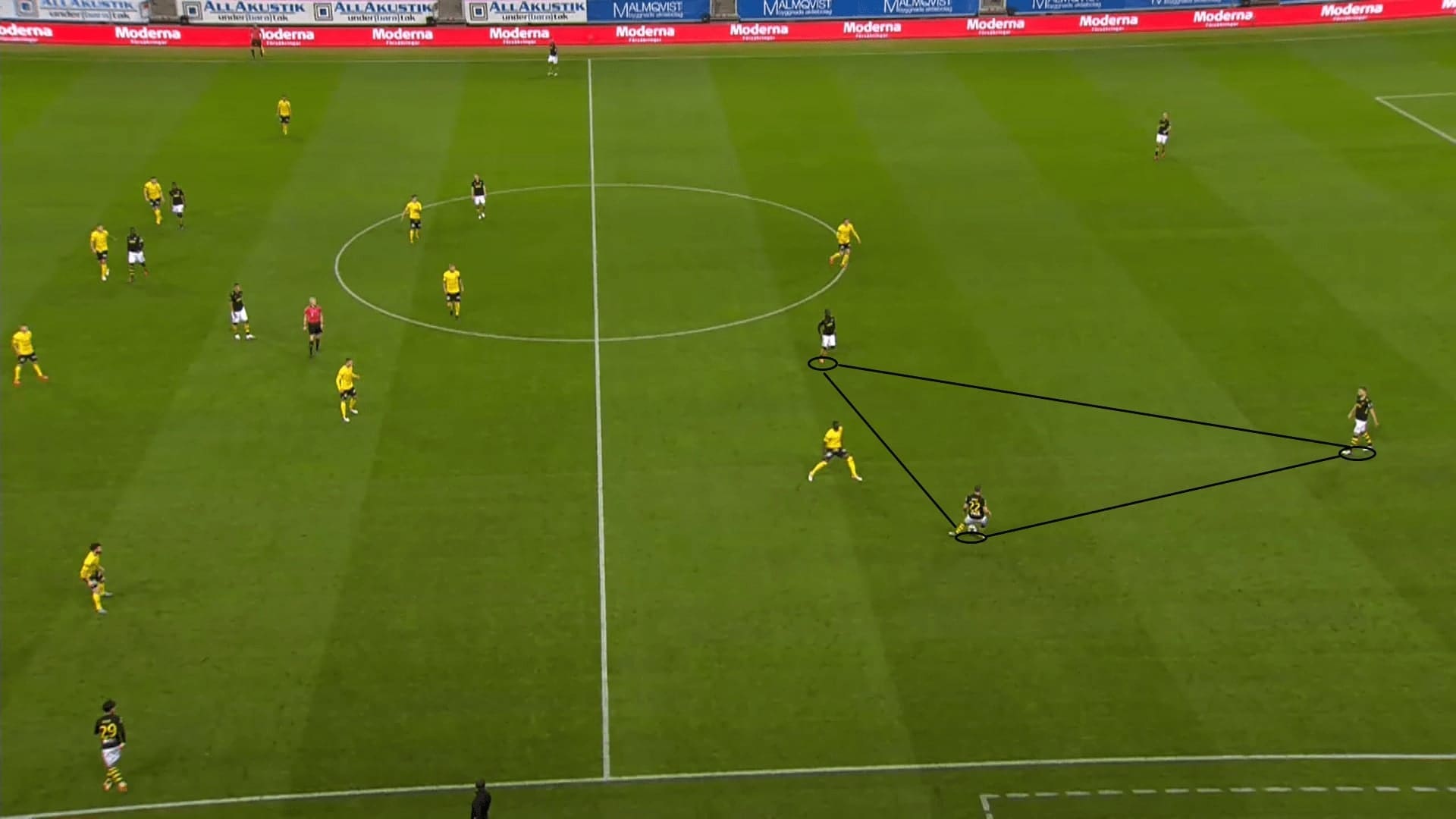
The graph below shows top passing links and average positions of players of AIK. Unsurprisingly, the players are well-connected with each other with an opened shape on the pitch. However, the issue was the one suggested above, limited access to central areas, or even the front three.
Right midfielder Larsson (#7) and right-back Mikael Lustig (#33) are closed to each other; left-back Kahl (#29) and left midfielder Rogić (#22) were closed to each other given their functions as explained.
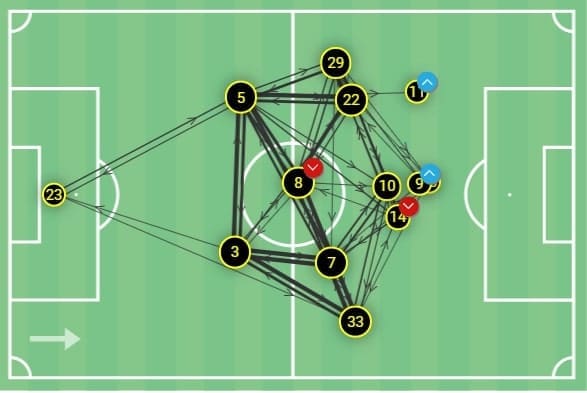
Chance creation in the final third
Inside the final third, the performance of AIK was okay, but the way they create the opportunity could be even better from the offensive structure. First, we have to bear in mind that the attacks were mostly developed at flanks, hence, the ball was more likely to appear at zone 10, 12, 13, and 15 instead of 14 and 11.
The intention of Mjällby was to compress spaces at flanks when the opponent passed into the wide areas. Therefore, the ability to get into the centre without circulating the ball through the backline was important. AIK have done this well enough to make the ball progression efforts count.
The first example shows Rogić receiving the ball from Mets, but development was formidable because of the limited progressive option was offered to the carrier. The winger moved in narrowly too early, leaving Kahl as the only supportive player, but he was marked. When Ogbu adjusted his position slightly close to Mets, Rogić did not have an option to pass. The attack lacked dynamism and it was easy for Mjällby to defend by going man-to-man.
Maybe exploiting the highlighted area through a dropping behaviour or a forward run is a viable option. But AIK seldom utilized these gaps and the blindside of wide defenders to attack with dynamism.
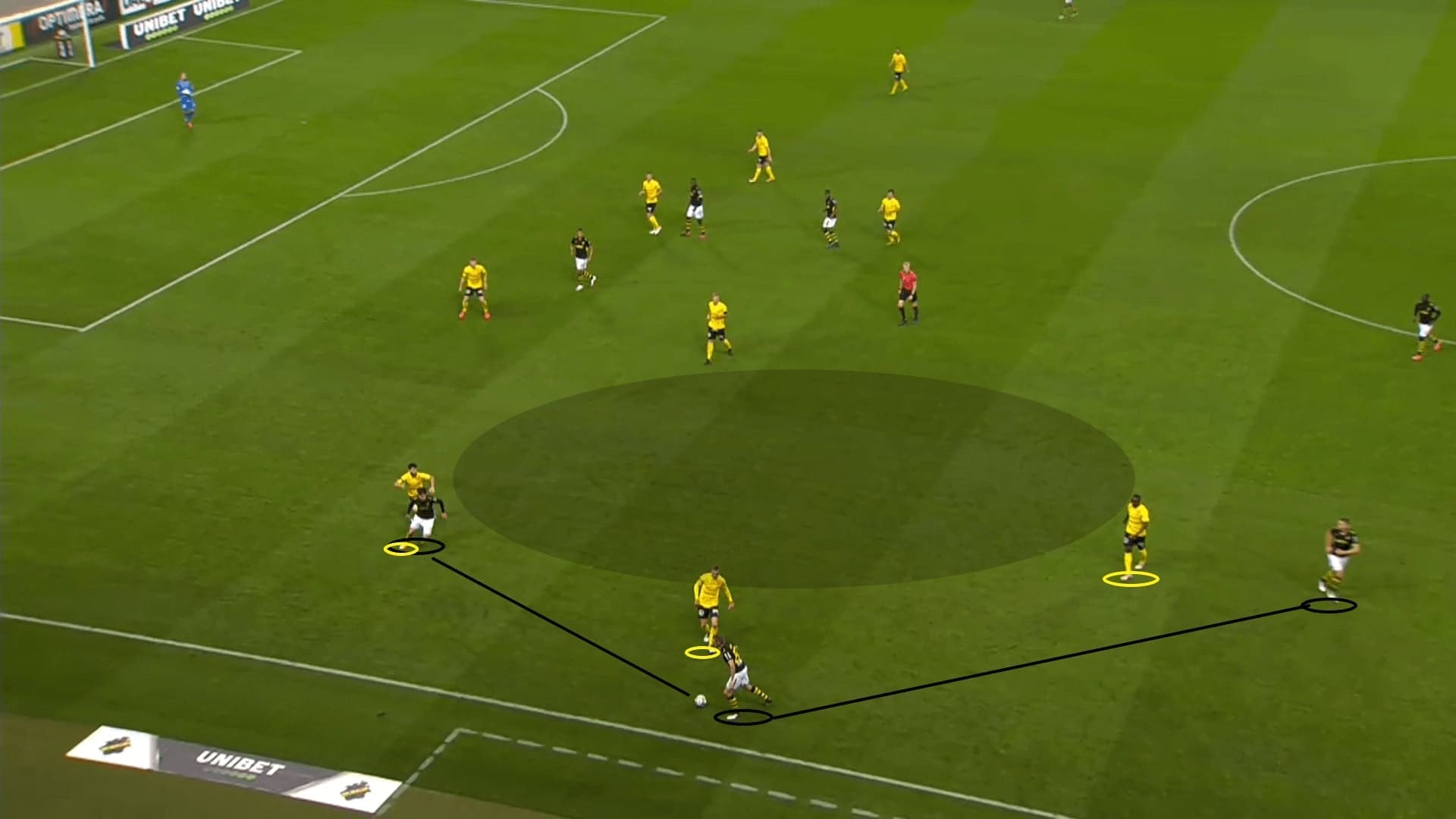
Another example here, on another flank. The right-back’s wide positioning has drawn Kadir Hodžić out of position based on the zonal principles as explained. Even the relative half-spaces were enlarged, players at the frontline did not instant exploit that corridor by making forward runs or inside-out runs.
Passing to Lustig seems fine, but this hardly offer any progression on the attack, and this was why the style of AIK was based on tiki-taka. They passed the ball without real intention or threat to harm the opposition in the early stages of the game.
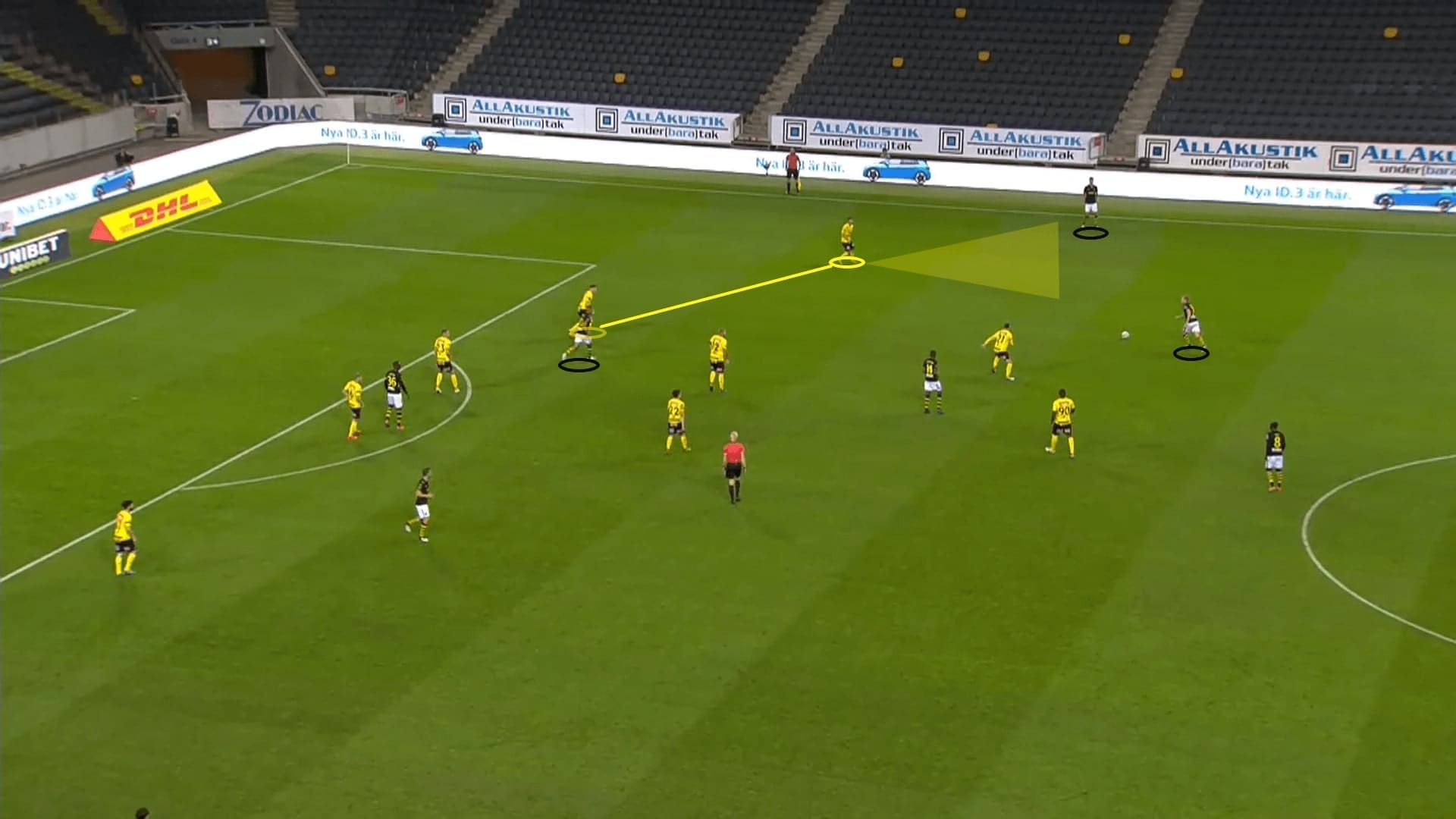
The xGs of AIK in the first half (0.54) and the second half (1.38) was a stark contrast on chances creation. Grzelak has made some adjustments to encourage his teams to attack with more runs during the halftime. Things were better in the second half.
For example, they exploited that relative half-spaces by forward runs, even sometimes not successful. In this example, the situation was similar to those in the first half, but this time Paulos Abraham was willing to run into that gap created by Lustig. At least, it forced Mjällby to adjust the shape to defend.
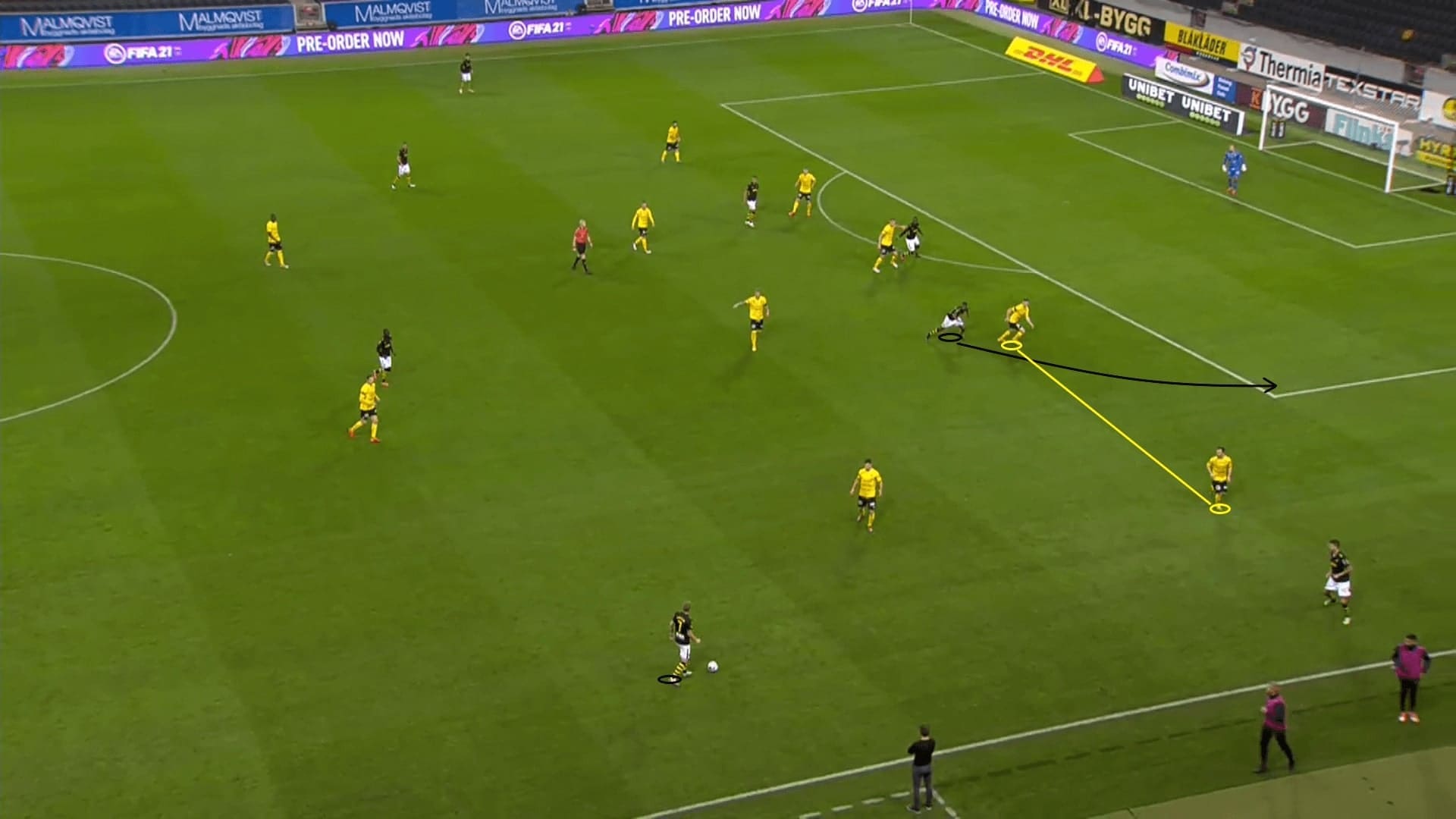
Still, at least two of the fronts three stayed narrowly to attack the penalty box. AIK had several ball circulation efforts in advanced areas of the pitch, capitalizing on the deeper Mjällby last line of defence, also entering zone 14 more often.
Another change of the team was the encouragement of early crosses, which directly created some best chances of the game. This was a solution to lacking supportive structure at flanks, as the manager believes the wingers should join the attack inside the penalty box. The below image had the former Ajax man, Kolbeinn Sigþórsson and Henok Goitom attacking the box, sometimes there are three or four players to overload that area.
Because of the zonal system, mostly Mjällby only had the centre-backs to defend at the centre. This numerical equality could be converted to 1 v 1 separations through reversed movements, or just simply creating traffics or attacking posts.
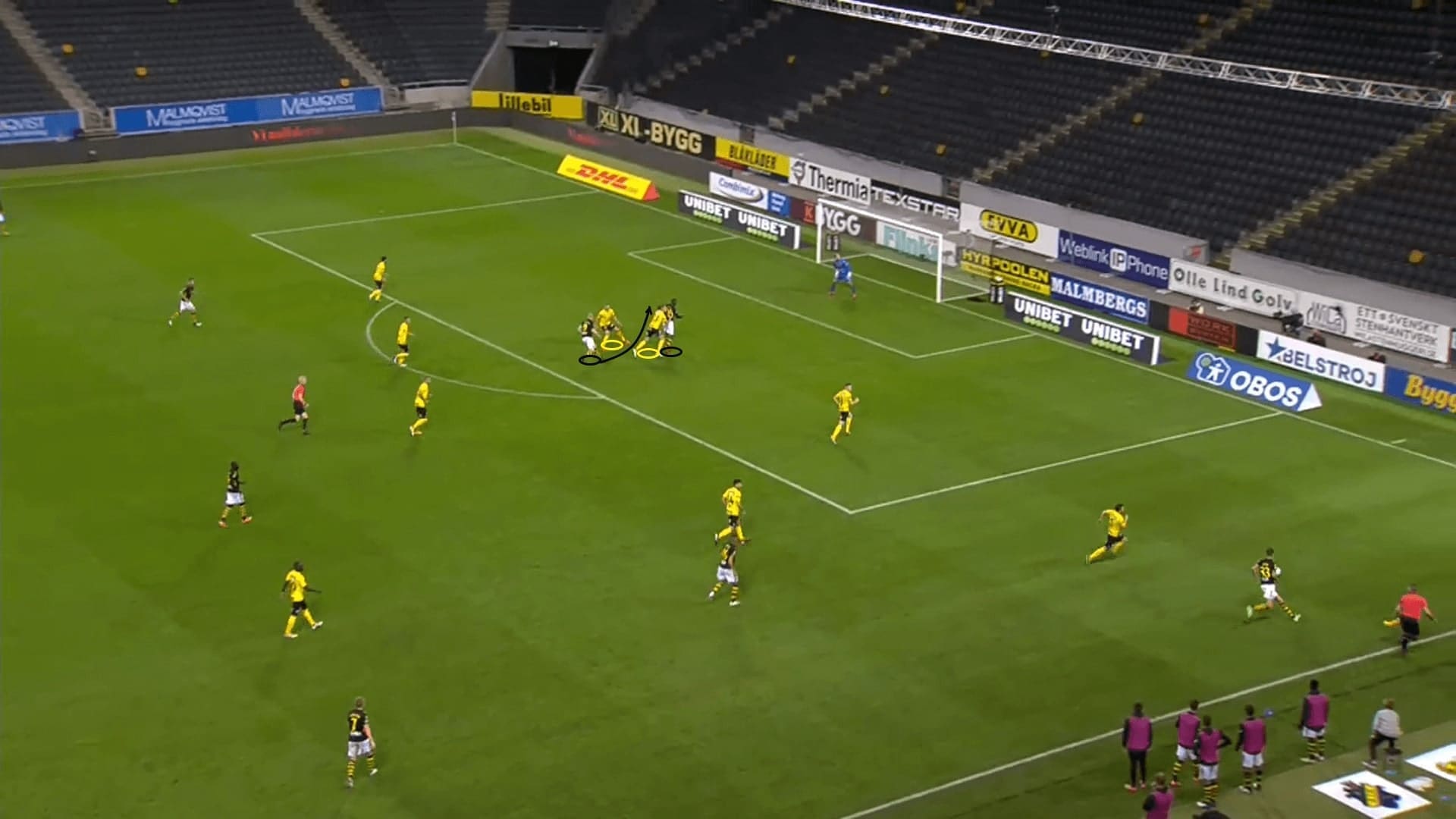
To sum up AIK’s offensive performance, they were a lot better in the second half. Although most of the shots came outside of the penalty box, the improvement was shown by attempts in the penalty area. Below is the shot map of AIK, for those five opportunities in the “golden zone”, four of them happened in the second half.
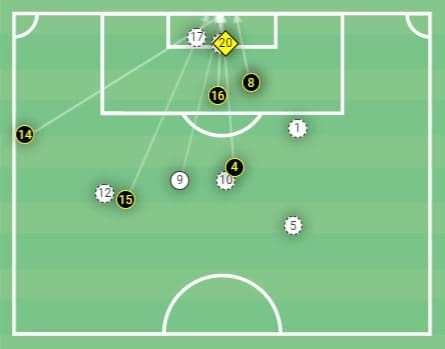
Mjällby countered the pressing trap
Apart from generating chances through offensive organizations, AIK also won the second balls at the outside of the box to counter-attacks in the final third. The best chance in the first half came from this pattern.
Throughout the game, AIK defended with high intensity, as shown by the below average PPDA graph of the team, at some stages the pressing intensity reached 4.1, which was extremely low.
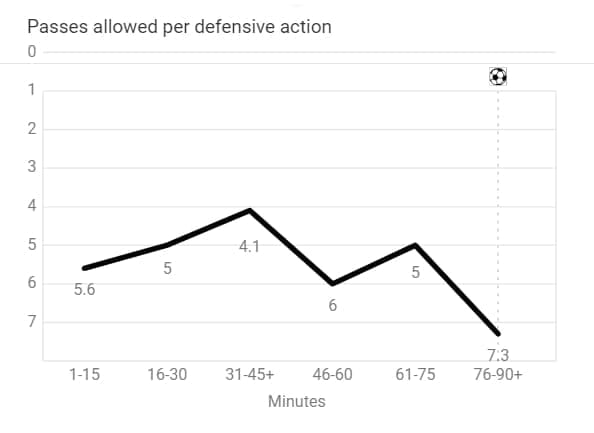
The defensive system of AIK was zone-oriented, starting with a 4-3-3 shape. The first line was a bit wide and the second one was narrower, the intention was to overload the centre, forcing the ball to flanks. At flanks, the widest player of each layer could join the pressing. Therefore, it was not a coincidence to see AIK having more recoveries at flanks then at the centre from their recoveries graph below.
However, the issue was the aggressiveness of challenges. They seldom attacked the ball or run past a player. This was how Mjällby broke the press to organize an attack, despite not being a team focusing on positional plays.
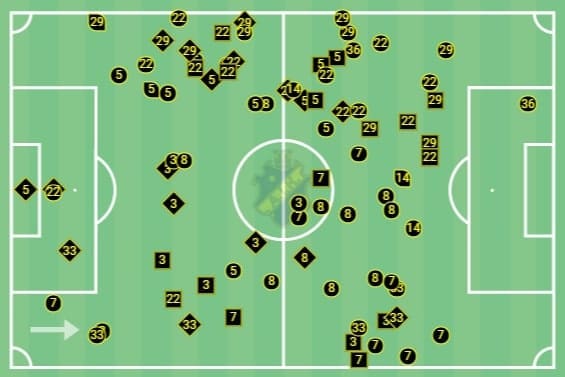
A very clever way for Mjällby to create the free player was to counter AIK’s pressing trap. In the offensive phase, the back five spread apart to occupy all vertical zones on the pitch, while the midfielders staying at the centre. So, the situation would be as follow: AIK having a 6 v 3 numerical advantage to block the midfield passing lanes.
Most ball circulation events of Mjällby happened between the back five. When the midfielders were unavailable, Lantz’s team would try to pass the ball wide, inviting pressure to the wide zone. Here, they played the ball to Tamimi.
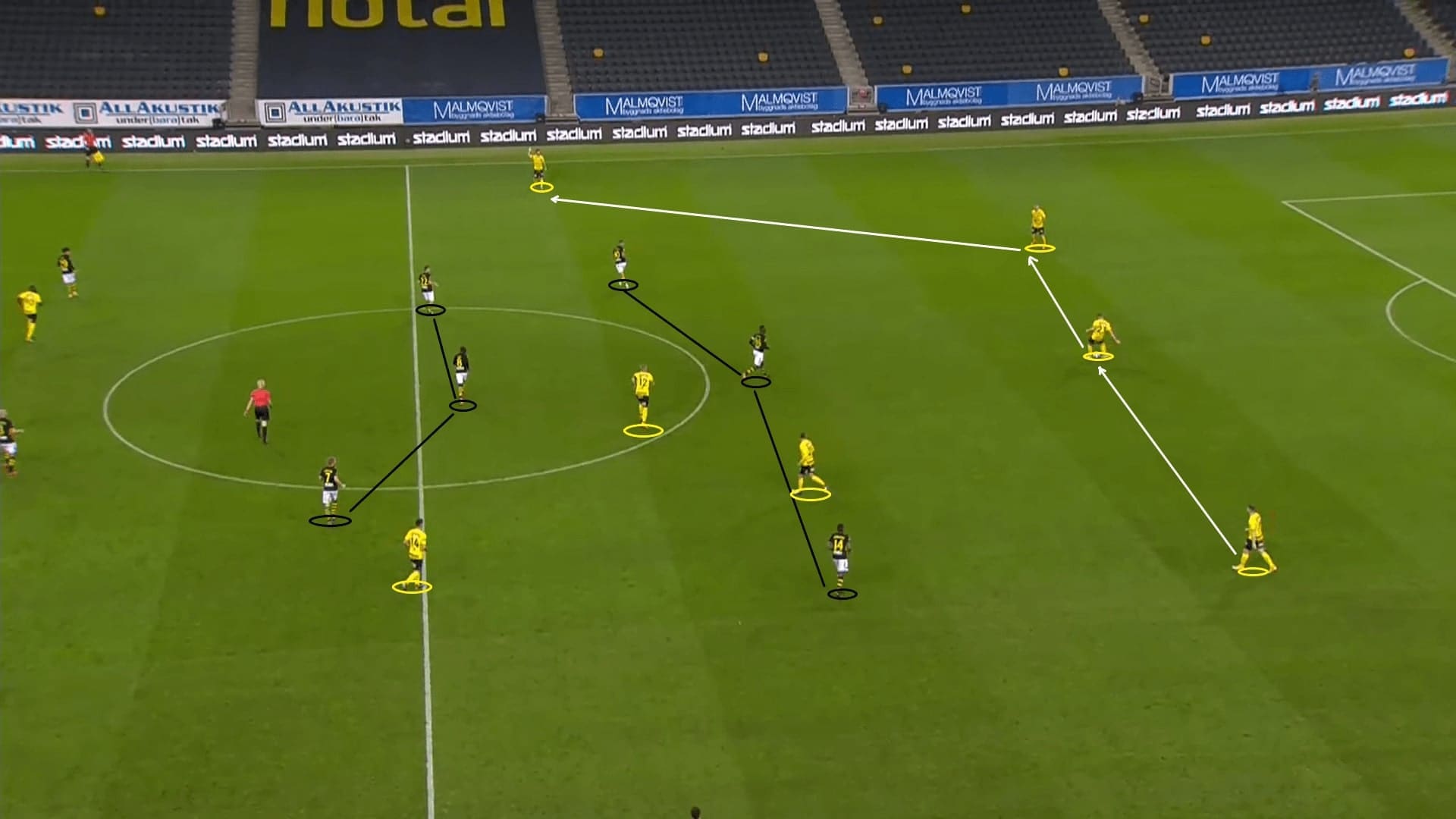
Consequently, most AIK players moved to the left flank, even the left-winger: Bahoui has done so. Since they seldom attacked the ball or effectively eliminating options by shutting passing lanes, Mjällby still have rooms to escape from the player-abundant side.
Here, Tamimi returned the ball to Eric Björkander, and now, the free player appeared. David Löfquist was unmarked given the far side winger of AIK never tucked into the centre. The return pass was another trap to draw Goitom wide, eventually, the midfielder could receive the ball with an opened body. These were the moments for Mjällby to hit into the final third directly.
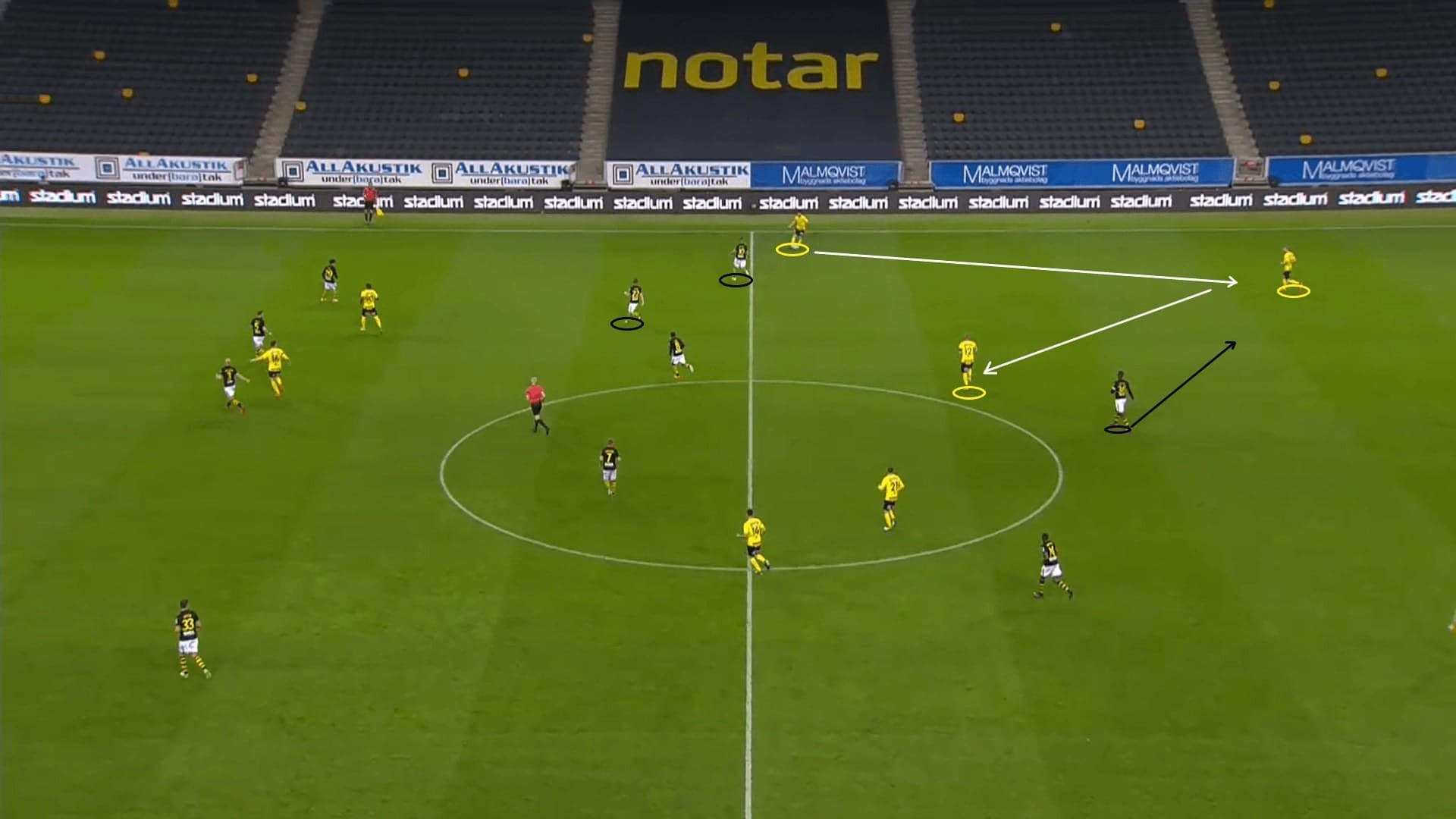
Offensively, Mjällby were a very direct team, with a pair of target men at the frontline. This has shaped the attacking pattern of the team, by using Ogbu or Bergström as the target, a lot of third man plays were used as a tool of progression. The strikers were clear about the job, seldom taking unnecessary touches, keeping things tidy.
Mjällby liked to use the wing-backs to provide the width and attack flanks. For example, the attacked develop from the left, using Bergström as the target, they found the midfielder at the centre. This third man quickly recognized Tamimi’s presence on the right flank, releasing the right wing-back diagonally, who ended up crossing into the box.
When Mjällby played like this, the tempo was too quick for AIK to catch. And only using these third man plays and crosses effectively, they were able to create the opportunities they needed.
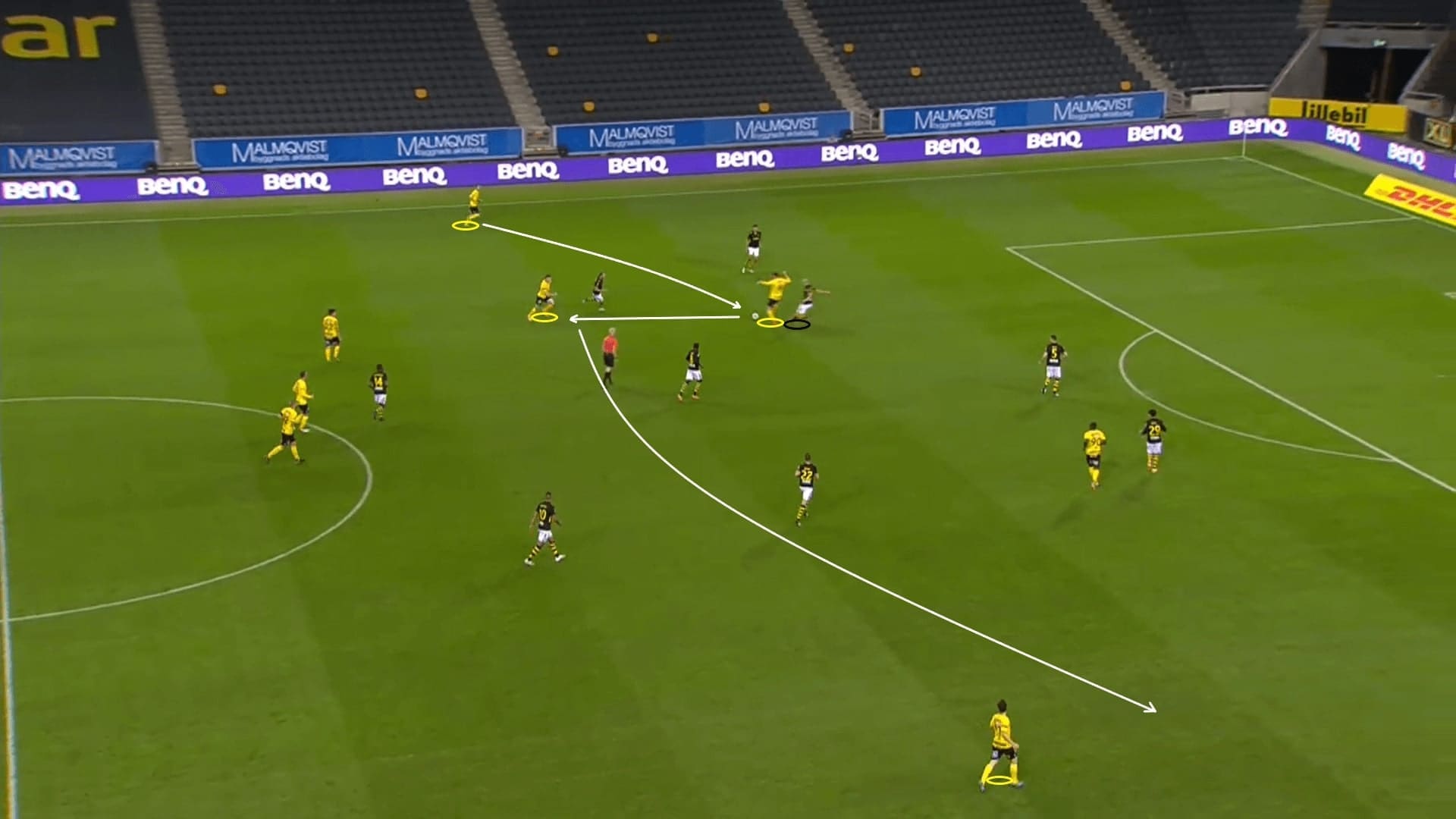
Final remarks
AIK were playing quite good in this game, most of the parts were in control, Mjällby sometimes found themselves difficult to counter because of the deep shape. Maybe, another day, AIK could’ve taken the chances better, having a larger victory. Anyway, their next opponent is Sirius, which was not an easy side to deal with.
Mjällby are having a Svenska Cupen game very soon, facing Assyriska BK from Swedish Football Division 2. Lantz should have enough quality of players to deal with the opponent, all they need is to recover from the loss and perform at a good standard.





Comments